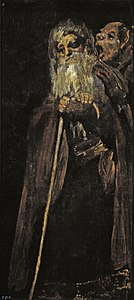art.wikisort.org - Pittura
Pitture nere (1819-1823) è il nome dato a una serie di quattordici opere murali di Francisco Goya, dipinte con la tecnica dell'olio su muro su pareti ricoperte di gesso. Sono state create come decorazione delle pareti della Quinta del Sordo[1], una casa da lui acquistata a Madrid nel febbraio del 1819. Questi murali sono stati trasferiti su tela nel 1874, e attualmente sono conservati nel Museo del Prado di Madrid.


Storia
L'insieme di dipinti, ai quali Goya non diede titolo, fu catalogato nel 1828 da Antonio de Brugada[2], amico di Goya, che li denominò come segue: Atropo, Due uomini anziani, Due vecchi che mangiano, Duello rusticano, Il sabba delle streghe, La lettura, Giuditta e Oloferne, Il pellegrinaggio a San Isidro, Due donne e un uomo, Pellegrinaggio alla fontana di San Isidro, Cane interrato nella rena, Saturno che divora i suoi figli, La Leocadia, Visione fantastica.
Nel 1823 la casa con i dipinti passò ad essere di proprietà di Mariano Goya, suo nipote, che ebbe il compito di preservarla da possibili ritorsioni dopo il ripristino della monarchia assoluta e la repressione dei liberali condotte da Ferdinando VII di Spagna. L'esistenza delle Pitture nere rimase scarsamente conosciuta per circa 50 anni, fin quando, nel 1874, il banchiere franco-tedesco Émile Baron d'Erlanger, nuovo possessore della Quinta, ne ordinò il trasferimento su tela col fine di esporle all'Esposizione universale di Parigi del 1878.[3] Nel 1881 fu lo stesso banchiere a donarle al Museo del Prado, dove sono attualmente esposte.
Galleria d'immagini
- Saturno che divora i suoi figli, 1819–1823
- Cane interrato nella rena, 1819–1823
- Due uomini anziani, 1819–1823
- La lettura, 1819–1823
- Giuditta e Oloferne, 1819–1823
- Due donne e un uomo, 1819–1823
- La Leocadia, 1819–1823
- Duello rusticano, 1819–1823
- Due vecchi che mangiano, 1819–1823
- Pellegrinaggio alla fontana di San Isidro, 1819–1823
- Il sabba delle streghe, 1819–1823
- Il pellegrinaggio a San Isidro, 1819–1823
- Visione fantastica, 1819–1823
- Atropo, 1819–1823
Note
- L’Arte Dannata di Goya: le Stregonerie e le Pitture Nere, su fineartsmag.com, FineArtsMag. URL consultato il 6 giugno 2017.
- (ES) Pinturas negras [Goya], su museodelprado.es, Museo del Prado. URL consultato il 6 giugno 2017.
- Saturno che divora i suoi figli di Goya: analisi completa del quadro, su arteworld.it. URL consultato il 6 giugno 2017.
Bibliografia
- Yves Bonnefoy, Goya, le pitture nere, Roma, Donzelli 2006. ISBN 8860360676, 9788860360670
Altri progetti
 Wikimedia Commons contiene immagini o altri file su Pitture nere
Wikimedia Commons contiene immagini o altri file su Pitture nere
| Controllo di autorità | BNF (FR) cb133239926 (data) |
|---|
На других языках
[en] Black Paintings
The Black Paintings (Spanish: Pinturas negras) is the name given to a group of 14 paintings by Francisco Goya from the later years of his life, likely between 1819 and 1823. They portray intense, haunting themes, reflective of both his fear of insanity and his bleak outlook on humanity. In 1819, at the age of 72, Goya moved into a two-story house outside Madrid that was called Quinta del Sordo (Deaf Man's Villa). Although the house had been named after the previous owner, who was deaf, Goya too was nearly deaf at the time as a result of a fever he had suffered when he was 46. The paintings originally were painted as murals on the walls of the house, later being "hacked off" the walls and attached to canvas by owner Baron Frédéric Émile d'Erlanger.[1] They are now in the Museo del Prado in Madrid.[fr] Peintures noires
Les Peintures noires (en espagnol : Pinturas negras, 1819-1823) sont une série de quatorze fresques de Francisco de Goya peintes avec la technique de l’huile al secco (sur la surface de plâtre d’une paroi) pour décorer les murs de sa maison, appelée la Quinta del Sordo (« Maison de campagne du Sourd »), que le peintre avait acquise en février 1819 ; ces fresques furent transférées sur toile entre 1874 et 1878. Elles sont actuellement conservées au Musée du Prado, à Madrid.- [it] Pitture nere
[ru] Мрачные картины
«Мрачные картины» (исп. Pinturas negras, встречается буквальный перевод «Чёрные картины»; 1819—1823) — название серии из четырнадцати фресок Франсиско Гойи, написанных в технике al secco (на стене, по увлажнённой штукатурке). Были созданы для стен своего дома, который он приобрел в феврале 1819 года, с интересным названием Дом Глухого, получивший название ещё при жизни бывшего владельца, вероятно, страдавшего глухотой. Эти фрески переносились на холст с 1874 года, на сегодняшний день они хранятся в музее Прадо в Мадриде.Другой контент может иметь иную лицензию. Перед использованием материалов сайта WikiSort.org внимательно изучите правила лицензирования конкретных элементов наполнения сайта.
WikiSort.org - проект по пересортировке и дополнению контента Википедии













